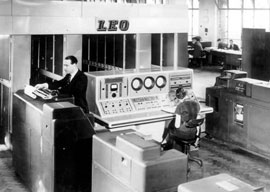
November 28, 2013

LEO 326
Fourth and last of these themes is what we now call the “user interface”: the way we interact with our digital, convergent, ever more sophisticated gadgets. This theme opens up into a broad terrain of speculation, at the far borders of which dwell the prophets of the singularity, an imagined point of future time at which the gadgets replace us altogether.
Ceruzzi resists the temptation to speculate. He sticks to the history, showing how user interface issues have been with us from the beginning”in the design of antiaircraft guns during World War II, for instance.
An engineer’s job was not finished once a machine was designed; he or she then had to fit that device into a human context”in that case, of newly recruited soldiers and sailors who had little background in advanced technology yet who were being asked to operate sophisticated radar and other electronic devices.
Recent developments, down to Facebook and, yes, Twitter, are adequately covered, with frequent reminders of continuity in those four major themes. Why, for example, are some websites more successful than others? Simplicity and lack of clutter, says Ceruzzi, as illustrated by the Google search screen.
Two other Web sites [sic] that consistently rank among the most visited, Wikipedia and Craigslist, also have a text-oriented design with few frills….These designs may seem a long way from the human factors work done during World War II on antiaircraft fire control devices, but they are the spiritual descendants.
The author also steers clear of the longstanding but petty controversy about which was the first modern electronic computer. The closest he gets is a reminder, when discussing the 1946 ENIAC machine, that the “C” in that acronym stands for “computer,” a word that up to that point (and still in the dictionaries of my childhood) referred to a human being”usually female”employed to carry out repetitive computations on mechanical adding machines.
Computing: A Concise History is neither more nor less than what it promises: an outline handbook on its topic, comprehensive yet parsimonious. The only fault I can find is somewhat of a bias toward hardware as against software. The author might have squeezed in a little more on the history of programming languages. It is possible, though, that my own bias as an old programmer (first language: ALGOL) is showing here.
I also regret that there is no mention of the Leo 326, a noble machine in its time and a triumph of British engineering. It was the last of a line originated by forward-looking managers in, of all places, the Lyons chain of tea shops. The assembler language was named Intercode, a cause for much ribald humor among programmers. The processor included a speaker so that you could hear your code executing. The operating system was named GEORGE. You never forget your first.